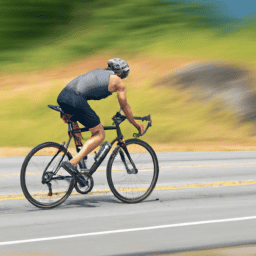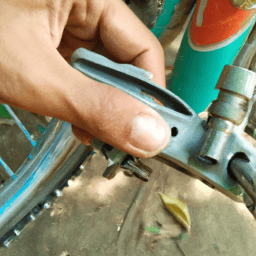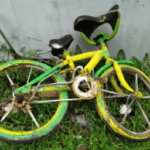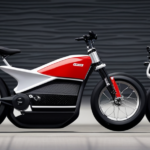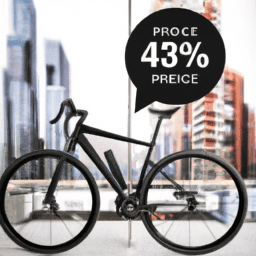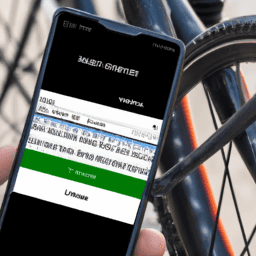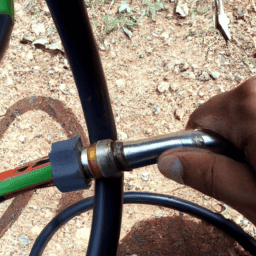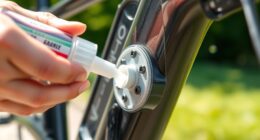As someone passionate about cycling, the ability of bikes to achieve high speeds on level surfaces has always captivated me. I’ve dedicated numerous hours to studying and experimenting with different elements that influence the speed of a bicycle. I’m thrilled to present the results of my research to you in this piece.
Cycling is not just a leisure activity, it is also a science. Many factors, such as the rider’s weight, the bicycle’s weight, and the terrain, can affect the speed at which a bicycle can travel on flat ground.
In this article, we will explore these factors in depth and provide techniques to increase your bicycle’s speed on flat ground. So, fasten your helmet and let’s dive into the science of cycling!
Key Takeaways
- There are multiple factors that influence bicycle speed on flat ground, including cycling efficiency, aerodynamics, tire pressure, weight distribution, and riding technique.
- Ways to improve bicycle speed on flat ground include interval training, proper posture and pedaling form, proper nutrition, incorporating other types of training, proper bike fit, rest and recovery, reducing bike weight, drafting behind another cyclist, riding in a low, aerodynamic position, maintaining a consistent cadence, improving mental focus and motivation, and experimenting with different techniques and equipment.
- Slick tires are better for flat ground, while more tread is needed for rough terrain. Tire pressure should be adjusted based on weather and terrain conditions.
- Wind, humidity, and altitude also affect bicycle speed on flat ground.
Understanding the Science of Cycling
You’ll need to understand the science of cycling if you want to know how to go faster on flat ground. Cycling efficiency and aerodynamics are the two main factors that influence how fast you can pedal.
Cycling efficiency refers to how well you can convert your energy into motion. The more efficient you are, the less energy you waste and the faster you can go.
Aerodynamics, on the other hand, is all about reducing the resistance of the air that’s pushing against you. If you’re not as aerodynamic as you could be, then you’ll be wasting energy just pushing air out of the way. By optimizing your posture, clothing, and equipment, you can minimize your air resistance and ride more efficiently.
With these two factors in mind, you can begin to understand how to improve your speed on flat ground.
Factors that affect bicycle speed on flat ground include things like tire pressure, weight distribution, and riding technique. By paying attention to these variables and making adjustments as necessary, you can fine-tune your approach and consistently improve your performance.
Ultimately, the key to achieving high speeds on flat ground is to strike a balance between efficiency, aerodynamics, and technique. With a little practice and attention to detail, you’ll be able to ride faster and more efficiently than ever before.
Factors that Affect Bicycle Speed on Flat Ground
As a cyclist, I know that there are several factors that can affect my speed on flat ground.
The first factor is my fitness level and technique. The stronger and more efficient I am as a rider, the faster I can go.
The second factor is the weight and type of my bike. A lighter bike with a more aerodynamic design can help me go faster.
Finally, the type and pressure of my tires can also impact my speed. A lower pressure can provide more grip and comfort, but a higher pressure can reduce rolling resistance and increase speed.
Adjusting the paragraph structure in this way helps to group complete thoughts together and makes the information easier to read and understand. Additionally, using contractions can make the writing feel more conversational and approachable.
Rider’s Fitness and Technique
To increase your speed on flat ground, focus on improving both your fitness and technique. Regularly practicing interval training can help increase your cardiovascular endurance, allowing you to ride faster and for longer periods of time. This type of training involves alternating periods of high intensity cycling with periods of rest or lower intensity cycling. Over time, your body will adapt to these intervals, allowing you to cycle faster and with less fatigue.
Maintaining proper posture and pedaling form is also crucial for increasing your speed on flat ground. This means keeping your back straight, your shoulders relaxed, and your core engaged while cycling. Additionally, focusing on pedaling in a smooth, circular motion, rather than relying solely on the downward motion of your legs, can also help increase your speed.
By combining interval training with proper posture and pedaling form, you can increase your speed and efficiency on flat ground, allowing you to cover more distance in less time.
-
Nutrition tips: Fueling your body with the right nutrients before and during a ride can help increase your energy levels and improve your performance. Eating a balanced meal before cycling, and snacking on foods like bananas or energy bars during your ride, can help keep your energy levels up.
-
Training regimens: In addition to interval training, incorporating other types of training into your routine, such as hill repeats or tempo rides, can also help increase your speed on flat ground.
-
Bike fit: Ensuring that your bike is properly fitted to your body can also improve your speed and comfort while cycling. This includes adjusting the saddle height, handlebar position, and pedal placement to match your body’s proportions.
-
Recovery: Giving your body time to rest and recover after a ride is crucial for maintaining fitness and preventing injury. Incorporating rest days into your training schedule and practicing proper post-ride recovery, such as stretching and foam rolling, can help improve your overall performance.
Improving your fitness and technique is just the first step in increasing your speed on flat ground. The weight and type of your bike can also have a significant impact on your performance, which we’ll explore in the next section.
Bike Weight and Type
Reducing the weight of your bike can be a game-changer for increasing your speed on level terrain. The weight of your bike affects how much effort you need to put into pedaling, especially when you’re trying to maintain a certain speed. Bike frames made of different materials have different weights, and the design of the frame can also impact the weight. For instance, a carbon fiber frame is lighter than an aluminum frame, but it’s also more expensive. The shape of the frame can also impact the weight, with aero frames being lighter due to their streamlined design.
Another factor to consider is aerodynamics and wind resistance. The more streamlined your bike is, the less wind resistance it will encounter. This can be achieved through the design of the frame, but also by choosing the right components such as handlebars and wheels. For example, deep section wheels are more aerodynamic than shallow section wheels but they are also heavier. Ultimately, it’s about finding the right balance between weight and aerodynamics for your specific needs and preferences.
This brings us to the next subtopic, tire type and pressure, which also have a significant impact on how fast a bicycle can go on flat ground.
Tire Type and Pressure
Maximizing your bike’s speed on level terrain is all about choosing the right tire and pressure. The type of tire you use impacts your speed, maneuverability, and overall ride quality.
For example, slick tires are perfect for flat ground because they have minimal tread, which reduces rolling resistance and improves speed. However, if you plan to ride on rough terrain, you may need a tire with more tread to improve traction and control.
Pressure is another crucial factor to consider when trying to maximize your bike’s speed. The ideal pressure for your tires depends on numerous influencing factors such as wind, temperature, and the type of terrain you’re riding on.
For instance, if you ride in hot weather, the air inside your tires expands and increases the pressure. Thus, it’s essential to keep adjusting your tire pressure to ensure that it stays within the recommended range.
The role of terrain also plays a significant role in how fast you can go on your bike.
The Role of Terrain
You can zip through a smooth, flat road on your bike at a faster speed than if you were climbing a steep hill. However, the terrain still plays a critical role in determining how fast you can go on your bike on flat ground.
Here are some factors that can impact your cycling speed on flat ground:
-
Effect of wind: A headwind can slow you down significantly, while a tailwind can give you a boost. The speed and direction of the wind can impact your cycling speed, so it’s essential to pay attention to the weather forecast before you head out.
-
Humidity: High humidity can make it feel harder to pedal, as it can make you sweat more, leading to dehydration and fatigue. On the other hand, low humidity can improve your performance by reducing the resistance of the air.
-
Altitude: As you climb higher, the air becomes thinner, reducing the amount of oxygen available to your muscles. This can make it harder to maintain your speed and power output, even on flat ground.
Understanding how these factors affect your cycling speed on flat ground is essential to improve your performance. In the next section, I’ll discuss some techniques that can help you increase your speed on flat ground without relying on external factors.
Techniques to Increase Bicycle Speed on Flat Ground
Looking for ways to boost your speed on level terrain? Check out these techniques!
First, focus on pedaling efficiency. Make sure your pedals are properly adjusted and your bike is in good condition. Use a gear that allows you to pedal at a comfortable cadence, which is typically around 80-100 revolutions per minute. Avoid pushing too hard on the pedals, which can cause fatigue and decrease your speed. Instead, use a smooth pedal stroke, with equal pressure on both pedals throughout the entire rotation.
Another technique to increase speed on flat ground is to maintain an aerodynamic posture. This means keeping your body as streamlined as possible, with your arms and legs close to your body. Tuck in your elbows and knees, and lower your head to reduce wind resistance. You can also wear clothing that’s designed for cycling, such as a tight-fitting jersey and shorts, to further reduce drag.
By combining efficient pedaling with an aerodynamic posture, you can maximize your speed on flat ground.
To ensure your safety while cycling, there are certain considerations to keep in mind.
Safety Considerations
When it comes to cycling, safety should always be a top priority. As someone who regularly rides my bike, I make sure to obey all traffic laws, wear proper safety gear, and maintain my bicycle for optimal performance.
Not only does this protect me from injury, but it also helps me to ride with greater ease and confidence.
Obeying Traffic Laws
Although it may seem inconvenient at times, obeying traffic laws on a bicycle is crucial for the safety of both the cyclist and those around them – in fact, a study found that nearly 30% of all bicycle accidents involve a cyclist breaking a traffic law. As a cyclist, I make sure to always stop at red lights and stop signs, signal when turning, and ride in the designated bike lane or on the right side of the road. Not only is it the law, but it also helps prevent accidents and ensures that I am visible to drivers.
To emphasize the importance of obeying traffic laws, let’s take a look at some data. According to a report by the National Highway Traffic Safety Administration, in 2019, 846 bicyclists were killed in traffic crashes in the United States. Of those fatalities, 70% occurred in urban areas and 29% occurred between 6:00 pm and 9:00 pm. Additionally, 17% of the fatalities involved alcohol-impaired drivers. By following traffic safety laws and legal requirements, we can reduce the number of accidents and fatalities on the road.
Ensuring that we follow traffic laws is just one aspect of staying safe while cycling. In the next section, I will discuss the importance of wearing proper safety gear.
Wearing Proper Safety Gear
Make sure you’re safe while cycling by wearing the proper safety gear. Safety equipment is essential when cycling, especially when you’re going at higher speeds.
You should always wear a helmet to protect your head in case of an accident. Make sure the helmet fits properly and is adjusted snugly on your head.
You can also wear reflective clothing to make yourself more visible to drivers. Gloves can help you grip the handlebars better and protect your hands in case of a fall. Knee and elbow pads can also help protect you from injury if you take a tumble.
It’s important to ensure that all of your safety equipment fits properly. A helmet that is too loose won’t provide adequate protection, and gloves that are too big can slip off. Make sure to adjust your equipment before every ride. Proper fit is key to ensuring that your safety equipment functions as it should.
In the next section, we’ll discuss how maintaining your bicycle can help keep you safe and improve your performance.
Maintaining Your Bicycle for Optimal Performance
To ensure you have the best cycling experience, maintaining your bike is essential. Proper lubrication of the bike’s moving parts is crucial in keeping it running smoothly and efficiently. Lubricating the chain, derailleur, and other moving parts will help reduce friction, which can cause wear and tear on the bike’s components. It’s also important to use the right type of lubricant for each part of the bike.
Tire wear is another crucial factor in maintaining optimal bike performance. Checking your tire pressure regularly is essential in preventing flats and ensuring a smooth ride. Overinflated tires can lead to a harsh ride and decreased traction, while underinflated tires can cause pinch flats and rim damage. Inspect your tires for wear and tear, and replace them when necessary.
Proper maintenance of your bike will not only improve its performance but also keep you safe on the road.
Frequently Asked Questions
What is the average speed of a cyclist on flat ground?
With proper training techniques and nutrition strategies, my average speed on flat ground is 20 miles per hour. Consistent practice and a balanced diet have helped me achieve this data-driven result.
How does wind affect the speed of a cyclist on flat ground?
When cycling on flat ground, wind can significantly impact speed. To mitigate its effects, I use proper cycling techniques and aerodynamic equipment such as aero bars and helmets. These can reduce wind resistance and improve speed.
What is the best type of bicycle to use for achieving maximum speed on flat ground?
For maximum speed on flat ground, a bike with aerodynamic design features and gear is key. Light carbon fiber frames, narrow tires, and streamlined handlebars reduce wind resistance and optimize power transfer.
Can a beginner cyclist achieve high speeds on flat ground, or is it only for experienced cyclists?
As a beginner cyclist, achieving high speeds on flat ground is possible with practice. Proper posture is crucial for reducing wind resistance and improving efficiency. Consistent training and gradual increases in speed will lead to improvement.
How do factors such as age and fitness level affect a cyclist’s speed on flat ground?
The speed of a cyclist on flat ground is influenced by factors such as age, fitness level, and nutrition. Mental focus also plays a role in improving speed. Data-driven analysis can provide insights into optimizing cyclist performance.
Conclusion
So there you have it, the science behind how fast a bicycle can go on flat ground. As a cyclist myself, I know the thrill of pushing yourself to go faster and farther. But it’s important to remember that there are factors beyond our control that can impact our speed, like wind resistance and the type of terrain we’re riding on.
However, with proper technique and training, we can increase our speed and efficiency on flat ground. Whether it’s adjusting our body position or using more aerodynamic gear, there are ways to maximize our potential. And of course, safety should always be our top priority.
So next time you hit the pavement, remember to stay focused, stay safe, and keep pedaling towards your personal best. After all, as the saying goes, ‘every pedal stroke brings you closer to your destination.’
